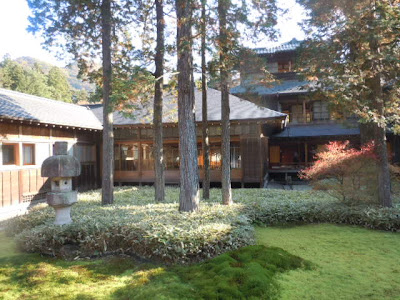 |
| Mineko at Nikko station |
With two seasoned Japanese travelers calling the shots, I saw more of Nikko in thirty-six hours than the Ancient Mariner and I could have covered in a week. Let's hope the Navy finds someone to replace him by April 1 so we can reprise this trip before we leave Japan next summer.
 |
| Hotel Japan shuttle bus |
Mineko and Misa are remarkably adept at snagging seats on public transportation so I was blessed with the breathtaking views afforded by a window seat all the way up the long, winding incline to the lake district.
 |
| Mineko, Misa, and Ouiser at Kegon Falls |
We took a rather frightening elevator ride to the base of the falls to get the most impressive view. The trees around the waterfall are exceptionally colorful at this time of year although I wouldn't mind seeing the waterfall in winter as well since I hear it often freezes almost completely solid.
Another bus took us back down those hairpin turns and deposited us across the road from Tamozawa Imperial Villa, a summer residence and retreat for the Emperor and his family beginning in 1899. The villa fell into disrepair after the war but was restored by the city and opened to the public in 2000.
There are few things in life I enjoy more than poking my nose in other people's houses. Padding through Tamozawa Imperial Villa in my stocking feet and watching a video of the building's history was worth ten times the price of admission. This is where Emperor Hirohito, the Showa Emperor, spent the last year of the war and here I was, more than sixty-five years later, admiring his billiard room and remarking that his back staircase was a narrower replica of the staircase back home where my two older brothers used to suspend Brother #3 upside down until all the pennies -- probably four on a good day -- fell out of his pockets.
The villa seemed enormous to me but I later learned it is nowadays less than one-third its original size. In 1922 the villa was comprised of 106 rooms and 107,000 square meters. Yet it is still one of the largest wooden buildings in Japan and the interior is an interesting combination of Japanese and Western styles. Some floors are carpeted and many ceilings sport elaborate chandeliers but sliding paper doors and tatami flooring are also very much in evidence.
 |
| The Interview Room |
As much as I longed to narrate "The Emperor's New Clothes" from memory, I controlled myself.

No comments:
Post a Comment